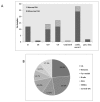The Relationship between Mitochondrial Respiratory Chain Activities in Muscle and Metabolites in Plasma and Urine: A Retrospective Study
- PMID: 28287425
- PMCID: PMC5373000
- DOI: 10.3390/jcm6030031
The Relationship between Mitochondrial Respiratory Chain Activities in Muscle and Metabolites in Plasma and Urine: A Retrospective Study
Abstract
The relationship between 114 cases with decreased enzymatic activities of mitochondrial respiratory chain (MRC) complexes I-V (C I-V) in muscle and metabolites in urine and plasma was retrospectively examined. Less than 35% disclosed abnormal plasma amino acids and acylcarnitines, with elevated alanine and low free carnitine or elevated C4-OH-carnitine as the most common findings, respectively. Abnormal urine organic acids (OA) were detected in 82% of all cases. In CI and CII defects, lactic acid (LA) in combination with other metabolites was the most common finding. 3-Methylglutaconic (3MGA) acid was more frequent in CIV and CV, while Tyrosine metabolites, mainly 4-hydroxyphenyllactate, were common in CI and IV defects. Ketones were present in all groups but more prominent in combined deficiencies. There was a significant strong correlation between elevated urinary LA and plasma lactate but none between urine Tyrosine metabolites and plasma Tyrosine or urinary LA and plasma Alanine. All except one of 14 cases showed elevated FGF21, but correlation with urine OA was weak. Although this study is limited, we conclude that urine organic acid test in combination with plasma FGF21 determination are valuable tools in the diagnosis of mitochondrial diseases.
Keywords: FGF21; mitochondrial disease; mitochondrial respiratory chain; plasma amino acids; plasma carnitines; urine organic acid.
Conflict of interest statement
The authors declare no conflict of interest.
Figures





References
-
- Chinnery P.F. Mitochondrial disorders overview. In: Pagon R.A., Adam M.P., Ardinger H.H., Wallace S.E., Amemiya A., Bean L.J.H., Bird T.D., Ledbetter N., Mefford H.C., Stephens K., et al., editors. GeneReviews. University of Washington; Seattle, WA, USA: 2014.
-
- Parikh S., Goldstein A., Koenig M.K., Scaglia F., Enns G.M., Saneto R., Anselm I., Cohen B.H., Falk M.J., Greene C., et al. Diagnosis and management of mitochondrial disease: A consensus statement from the Mitochondrial Medicine Society. Genet. Med. 2015;17:689–701. doi: 10.1038/gim.2014.177. - DOI - PMC - PubMed
LinkOut - more resources
Full Text Sources
Other Literature Sources
Miscellaneous

